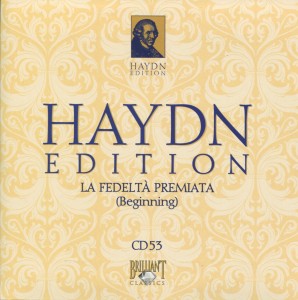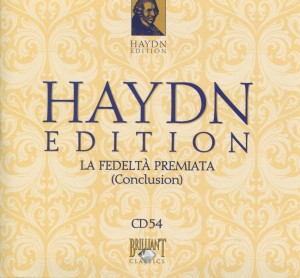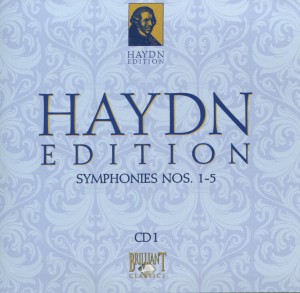 La Fedelta Premiata is an opera in three acts composed by Franz Joseph Haydn “first performed at Eszterháza on 25 February 1781 to celebrate the reopening of the court theatre after a fire. It was revised for a new version first performed in 1782,” according to its entry on Wikipedia. It was composed in 1780. Haydn was 48.
La Fedelta Premiata is an opera in three acts composed by Franz Joseph Haydn “first performed at Eszterháza on 25 February 1781 to celebrate the reopening of the court theatre after a fire. It was revised for a new version first performed in 1782,” according to its entry on Wikipedia. It was composed in 1780. Haydn was 48.
I liked it from the first few bars of the Overture.
That’s probably because I love orchestral music, played allegro con spirito – and Haydn’s Overture to La Fedelta Premiata is very spirited, indeed.
So is the Introduction, when the voices first appear (as a chorus).
The cast:
Amaranta: Ellen van Haaren soprano
Nerina: Maja Roodveldt soprano
Diana: Ester Beens soprano
Celia: Xenia Meijer alto
Fileno: Patrick Henckens tenor
Lindoro: Frank Fritschy tenor
Perruchetto: Tom Sol baritone
Melibeo: Julian Hartman bass
The performers:
Esterhazy Chorus & Orchestra
Frank van Koten
The plot:
The people of Cumae worship Diana, goddess of hunting and chastity. Their rites however have been defiled by a nymph whose treachery has brought a curse on them. To propitiate the angry goddess, two faithful lovers must be sacrificed each year to a lake monster until a faithful lover can be found to offer his own life. Fidelity, therefore, is at a premium in Cumae, and victims are hard to find.
The plot is “part thriller about lovers being sacrificed to a monster, part burlesque sending up pseudo-classical and early romantic emotions”.
Once again, today’s CD (par for the course in the Brilliant Classics Haydn Edition) features a high-quality recording of an inspired performance at Haydnsaal, Esterhazy Castle, Eisenstadt, Austria. It must be Continue reading →
 I didn’t know what to say yesterday for Part I of Haydn’s opera La Fedelta Premiata.
I didn’t know what to say yesterday for Part I of Haydn’s opera La Fedelta Premiata. 

